 |
 | ||||||||
 |
 |
 |
 |
 |
Librairie | Recherche

Entrez, de préférence, deux mots. |
Page 1 sur 4 - 63 articles.
1 2 3 4 page suivante>>
| Notices sur les familles illustres et titrées de la Pologne | |||
Seweryn, Comte Uruski | |||
 |
Nombreuses sont les familles d’origines polonaises, habituées en France, et considérablement gênées par l’obstacle de la langue. Pour pallier cela, l’ouvrage de 1862 que nous rééditons a le mérite d’avoir été écrit en français, langue internationale par excellence, à une époque ou la Pologne n’existait plus en tant que nation. Pour toutes les familles titrées (Prince, Comte, Baron…) et toutes les familles nobles une notice très développée est donnée, retraçant l’historique de la famille, donnant l’origine et la date d’octroi (éventuel) des titres, les armoiries… Etude francaise la plus complète sur la noblesse polonaise. | ||
| |||

| LA DESCENDANCE DES BATTENBERG-MOUNTBATTEN | |||
Michel Sementery | |||
 |
En 1851, un prince allemand, Alexandre de Hesse brave sa famille en épousant morganatiquement une aristocrate polonaise. Naitront cinq enfants qui effaceront la "faute de leurs parents" en faisant des mariages prestigieux avec des membres de dynasties regnantes. Par ses mariages, la famille deviendra pratiquement l'équivalent d'une maison souveraine. Les descendants d'Alexandre se retrouvent en 2009 dans les familles souveraines ou regnantes de Grande-Bretagne, de Hanovre, de Grèce, de Hesse, de Bade, de d'Espagne, de Serbie, du Luxembourg et dans de nombreuses familles de l'aristocratie européenne. | ||
| |||

| Stemmario Fiorentino (Armorial Florentin) | |||
| |||
 |
A concise but comprehensive introduction in Italian and English helps the reader to collocate the Armorial in its correct historical context; special attention is given to the history of heraldic decorative arts and manuscript and bibliographical sources. An index of over 1200 coats of arms is included. Attributed to Bernardo Benvenuti, prior of Santa Felicita in Florence and an antique dealer of the grand duke of Tuscany, Ferdinando II de' Medici who methodically and competently collated ancient Armorials and prioristi, this important Florentine Armorial numbered among its manuscript sources (many of which have long been lost) a certain Libro Antiquo dell'Arme del 1302, the year in which Dante was exiled. This in itself is sufficient to render the importance of this codex. Within its pages the reader will find the coats of arms of all the families of Florence and from the surrounding countryside from whom the priori of the local government were drawn in the period from 1282 and 1531; inked and painted, they number over 1200 and can be consulted here through their alphabetic index. This Armorial, which is currently conserved in a private collection in Paris, was probably purchased from the Museo privato della Casa Fiorentina Antica created by Elia Volpi in Florence in the historic Davanzati palazzo, the furnishings of which were dispersed at an auction in New York in 1916. Apart from its significant aesthetic value, this Armorial is important because it documents the source of each coat of arms: in many cases these are gravestones or artistic monuments which have long since disappeared and faded from living memory, but the documentation in the Armorial makes it possible to assign the coat of arms to its family. The reader can admire the coat of arms of Dante's maestro, Ser Brunetto Latini, who penned the Livre du Trésor in France, as well as those of other well-known names from the fields of Literature, the Arts, Science and world history, ranging from Amerigo Vespucci to Cavalcanti and Boccaccio, Machiavelli and Guicciardini, Taddeo Gaddi and Galileo Galilei. Side by side with the coats of arms of the historic nobility and of lesser known families the reader will find the crests of the various Arts, the government offices and the magistrates, and of the sestieri and quartieri of Florence and their standards | ||
| |||

| Stemmario Bolognese (Armorial Bolognais) | |||
| |||
 |
A concise but comprehensive introduction in Italian and English helps the reader to collocate the Armorial in its correct historical context; special attention is given to the history of heraldic decorative arts and manuscript and bibliographical sources. The introduction is followed by the paleographic transcription of the hand-written notes to the coats of arms of the city families, and by the 1891 index of the reproduced coats of arms. This 18th-century Armorial - once the property of Ghiselli and then of a branch of the Malvezzi family - is now in a private collection in Paris and is made up of several heraldic manuscripts. It represents a fundamental source of information for the civic and religious history of Bologna. The main 1891 coats of arms can be attributed to two main artists. They include: 454 coats of arms of the capitani del popolo and podestà (from 1258 to 1532); 188 coats of arms of the legates and pontifical governors (from 1327 to 1747); 32 coats of arms of bishops of Bologna (from 1154 to the early 18th century); 26 coats of arms of cardinals (18) and popes (8) from Bologna, all listed in chronological order; 97 coats of arms of families from the senatorial nobility(42 extinct and 55 still flourishing at the time of the publication); 862 coats of arms of city families (with very interesting hand-written information transcribed in the appendix); 15 coats of arms of the colleges. By other artists are the coats of arms (24) of people who governed the city in different periods, of the 30 Arts and Crafts - of which two versions are reproduced - and of the 45 spiritual companies. Still other two artists executed the coats of arms (34) of the chapters and religious institutions, and those (37) of the several chivalric orders, respectively. A final manuscript reproduces some fifteen heraldic monuments placed in the cloister of the Dominicans, with the relating coats of arms (19) and inscriptions. The appendix includes four heraldic plates attributed to Pasquali Alidosi, and one plate by an anonymous artist. | ||
| |||

| Stemmario Trivulziano (The Trivulzian Armorial) | |||
MASPOLI Carlo | |||
 |
The Stemmario Trivulziano dates back to the second half of the 15th century, and is attributed to Gian Antonio da Tradate, an artist by trade. This volume, which is conserved in the Biblioteca Trivulziana of Milan, documents approximately 2000 family and community coats of arms of the ancient Duchy of Milan, which at that time had reached the peak of its territorial extension. This prestigious edition is enhanced by the blazons of the well-known Swiss heraldic expert, Carlo Maspoli, who has also penned the introduction to the coats of arms and the deeds of the Visconti and the Sforza families, dukes of Milan. | ||
| |||

| Jean de Monlevade, pionnier de la sidérurgie brésilienne | |||
Robert Guinot | |||
 |
Jean de Monlevade (1791-1872) est né dans un château proche de Guéret, au sein d'une des familles de la Marche. Après de brillantes études, il est devenu polytechnicien et ingénieur des mines. Il a en 1817, quitté définitivement la France pour s'établir au Brésil. Il a mis toute sa compétence au service du Minas Gerais où aujourd'hui, Joao Monlevade, une ville industrielle de 70.000 habitants porte son nom. Cet hommage rarissime illustre une formidable réussite totalement méconnue en France. | ||
| |||

| Stemmario Bosisio | |||
MASPOLI Carlo et PALAZZI TRIVELLI Francesco | |||
 |
The Stemmario Bosisio, once known as the Scotti Armorial, now bears the name of the donator who willed it to the Historical Archives of the Dioceses of Como. This is a heraldic manuscript with watercolour illustrations that dates back to the second half of the 18th century. It documents 972 coats of arms of families and communities, mostly of the Lombardy region; particularly well represented are the region of Lake Como and the surrounding valleys (Valtellina, Valchiavenna, Val d'Intelvi, Valsassina), Brianza, and also the Canton Ticino and the Canton Grigioni. This prestigious edition is enhanced by the blazons of the well-known Swiss heraldic expert, Carlo Maspoli; the genealogist Francesco Palazzi Trivelli, archivist of the State Archives of Sondrio, has contributed valuable brief historical notes for many families. | ||
| |||

| Armorial universel contenant les armes des principales Maisons Estatz et Dignitez des plus considerables Royaumes de l'Europe | |||
Charles Segoing | |||
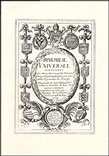 |
Ce volume contient plus de 1000 blasons gravés par Pierre Nolin, et appartenant aux familles royales, à la noblesse aux plus importants dignitaires ecclésiastiques du temps de Louis XIV, ainsi qu'aux principales familles Anglaises et allemandes, des cantons suisses, du royaume espagnol et des villes et territoires des actuelles belgique et Hollande. | ||
| |||

| Regum Pariumque Magnæ Britanniæ historia genealogica | |||
Jacobi Wilhelmi Im-Hoff | |||
 |
This monumental work by Jacob Wilhelm Im-hoff, well known in Italy for his Genealogiæ viginti illustrium in Italia familiarum, contains 137 genealogies and 163 coats of arms of the royal families of Great Britain and those of the British aristocracy (Lords). | ||
| |||

| Le jardin d'armoiries contenant les armes de plusieurs Nobles Royaumes & Maisons de Germanie Inferieure | |||
Jean Lautte | |||
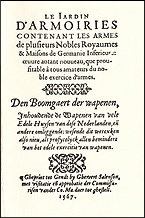 |
This volume, which has an introduction in French and Dutch, contains over 1000 coats of arms - engraved using the xylography technique - and the respective French blazoning, of families from Belgium, Holland and the surrounding countries, as well as the crests of the European sovereigns who were ruling at the time of Charles V. | ||
| |||

| Lo splendore della nobiltà napoletana ascritta ne' cinque seggi. Giuoco d'arme | |||
Carlo Torelli | |||
 |
This rare volume is particularly sought after for the exquisite plate of notable dimensions which illustrates 183 coats of arms of the Neapolitan nobility, subdivided into the five seggi (seats); the coats of arms are blazoned, with a descriptive comment and an explanation of the game is provided. | ||
| |||

| Genealogiæ viginti illustrium in Italia familiarum | |||
Jacobi Wilhelmi Im-Hoff | |||
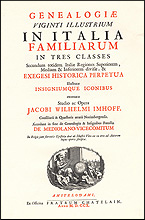 |
This work, as rare as it is well known, of the genealogist Im-hoff is of particular interest to Italy; in fact, it illustrates the coats of arms and genealogies of 20 of the most famous of the Italian noble families: among the reigning families are the Cybo, dukes of Massa and princes of Carrara, the Farnese dukes of Parma and Piacenza, Pico duke of Mirandola and Concordia, and Medici, grand dukes of Tuscany and princes of Ottajano; but the volume also includes the Milanese Biraghi (who are also Piedmont in origin), Homodei and Trivulzio (Gallio Trivulzio), the Sfondrati of Cremona (the family of Pope Gregory XIV), the Ferrero of Masserano from the Piedmont, the Tuscan (counts) Guidi, Piccolomini, Salviati and Strozzi, the powerful and domineering Roman families Orsini and Colonna, with their numerous branches in the Kingdom of Naples, where flourished the Giudice family, princes of Cellamare and dukes of Giovinazzo (but of Genoese extraction), the Neapolitan Pignatelli and Gambacorta, the powerful Sanseverino, and the Ruffo of Calabria. The volume concludes with a curious genealogy of a Belgian branch of the Milanese Visconti. | ||
| |||

| Histoire genealogique de la Maison Royale de Savoye | |||
F. M. Ferrero di Lavriano | |||
 |
In this splendid work Abbot Ferrero di Lavriano exalts the genealogical tree of the House of Savoy, which he maintains descends from a certain Beroldo, son of Ugone, duke of Saxony, born in 980 at Magdeburg. The work contains etchings of all the 34 descendants of the legendary progenitor through to Victor Amedeus II, with a description of their deeds. | ||
| |||

| Armorial du Royaume des Pays-Bas | |||
Jacques de Neufforge | |||
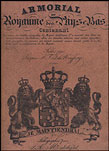 |
Cet armorial, compilé par Jacques de Neufforge, a été publié à Bruxelles en 1827, à l'époque où la Belgique faisait encore partie du royaume des pays-Bas, ce qui explique pourquoi cet inventaire comprend 693 blasons de familles Belges et hollandaises. Ce livre est particulièrement intéressant car les blasons sont réalisés en couleur, au lieu d'être simplement représentés en noir et blanc. | ||
| |||

| Libro d'Oro della Nobiltà di Genova | |||
Angelo Scorza | |||
 |
Published in a limited and numbered edition in 1920, this Armorial of the Genoese nobility is now a rare work, sought after both as an inventory and for its 38 fine plates which illustrate the coats of arms of the sestieri of Genoa, of the 28 hotels which formed the patriciate, and of all the 865 noble families of the cities, be they extinct or flourishing. | ||
| |||

| Wappenbuch des Heiligen Römischen Reichs | |||
Johann Siebmacher | |||
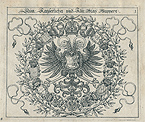 |
Edition of the famous armorial published in Nürnberg in 1605, displaying as many as 3471 coats of arms of the German, Austrian and Swiss nobility, and of Bishopries, Abbeys and Municipalities. | ||
| |||

| Araldica Tridentina. Stemmi e famiglie del Trentino | |||
Gian Maria Rauzi | |||
 |
In questa fondamentale opera pubblicata a Trento nel 1987 ben 367 sono le famiglie del Trentino - Alto Adige cui è dedicata una scheda con notizie storiche e raffigurante uno o più stemmi, tratti da antichi stemmari e monumenti araldici. | ||
| |||

| Storia genealogica della nobiltà e cittadinanza di Firenze | |||
G. M. Mecatti | |||
 |
Questa importante opera pubblicata a Napoli nel 1754 dall’Abate Mecatti fornisce notizie genealogiche sulle famiglie del patriziato fiorentino elencandone priori e senatori. | ||
| |||

| BLASONE BOLOGNESE, Stemmi delle famiglie nobili e cittadine di Bologna raccolti da Floriano Canetoli. | |||
Floriano Canetoli | |||
 |
Edizione dell’opera curata dall’Abate Dal Fiore e stampata a Bologna (1791-1795) da Floriano Canetoli raffigurante a colori ben 1308 stemmi e 1088 cimieri di famiglie nobili, 2315 stemmi di famiglie cittadine e gli stemmi e gli abiti da parata delle Arti e delle Confraternite cittadine. | ||
| |||

| LA NAVARRE DES PRINCES ETRANGERS, DU XIIIème au XVème SIECLES, | |||
LEROY, B. | |||
 |
Un état ibérique gouverné depuis le XIIIème siècle par des princes français, telle est l’identité de la Navarre. Tous les princes étrangers qui se sont succédé à sa tête ont créé une administration alliant droit français et coutumes locales. La rencontre de deux sociétés. | ||
| |||

Page 1 sur 4 - 63 articles.
1 2 3 4 page suivante>>


|
Sommaire Librairie Edition/Diffusion Recherches Articles Tables des Noms Contacts presse Informations Légales |